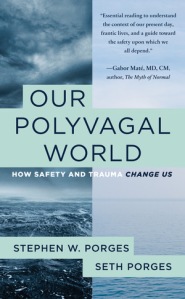I was tempted to post a glowing review as soon as I finished reading this book but held off. I wanted to see if time did anything to dull the glow. It’s been three weeks now and my feelings about this book are as shiny as ever.
Oftentimes when I find a book I expect to be life changing, I come away disappointed. When I do connect with a concept, I always plan on applying what I’ve learned to my life but then I move on to the next thing and my good intentions remain just that.
This book, though. It felt like entire chunks were written specifically with me in mind and the follow through? It actually happened!
I’ve been interested in learning about Polyvagal Theory but until now I’d never made it past the science speak. This is the first book I’ve found that doesn’t talk at you like a textbook but invites you to understand, using examples that are relatable. Examples like dogs and the Hulk.
So, what’s Polyvagal Theory all about?
How safe we feel is crucial to our physical and mental health and happiness.
Sounds obvious, right? How safe we feel can be different to how safe we are, though, and that’s a crucial distinction here.
By the end of this book, you’ll be well versed in the vagus nerve and why it matters. You’ll gain a better understanding of trauma: why we respond the way we do when traumatic events happen and why the impacts of such events make so much more sense than you’ve probably ever realised.
The impact of trauma is not isolated to our brains, but stretches through our nervous system to virtually every part of our body, changing how our senses sense, how our organs operate, and just about every aspect of our physical and mental health.
The first part of the book explains Polyvagal Theory in a way that made sense to me. I understood the sciencey bits and the examples that explained the sciencey bits, and I was able to apply it to specific parts of my life. I make more sense to me now! And the bonus is, so do other people!
To give you just one example, life experiences have made me particularly wary of breathing exercises. Many well meaning individuals have tried and failed to teach them to me over the years. It wasn’t until I learned from this book the best way to do them (because science) and how doing them helps (also science), that I was able to attempt them without my body panicking. I’m now someone who can use breathing exercises (the scientific way for scientifically proven benefits) to regulate myself. And it helps!
Along the way, I discovered why I’m hypersensitive to sound, particularly background noise. I’m currently also working on my own theory (which I haven’t found research on – yet) about whether the proximity of the trigeminal nerve to the vagus nerve may explain why I experience the pain pattern associated with trigeminal neuralgia after I spend a considerable amount of time in the red zone.
The second part of the book takes what you’ve learned and applies it to “circumstances and settings such as the pandemic, the workplace, schools, and prison.” While each of these chapters are helpful in their own right, by seeing how Polyvagal Theory applies to these, you are essentially given a road map to allow you to apply it elsewhere.
Then there’s the glossary, which amps up the science. If you don’t have a scientific background, you may not want to spend too much time here. I found I started to lose some confidence in what I had learned when I tried to decipher all of the science. Then I let it go. I didn’t need to be able to quote all of the right terminology to start making changes to my life.
This is a book I know I’ll keep coming back to. I expect I’ll need a refresher from time to time and as the circumstances of my life change, so will the parts of the book that speak to me.
I’ve already recommended this book to a bunch of people who work in the trauma field and I don’t think I’m going to be shutting up about it anytime soon.
Thank you so much to Edelweiss and Norton Professional Books, an imprint of W. W. Norton & Company, for the opportunity to read this book.
Once Upon a Blurb
The creator of the Polyvagal Theory explains the principles in simple terms that are accessible to all.
Since Stephen Porges first proposed the Polyvagal Theory in 1994, its basic idea — that the level of safety we feel impacts our health and happiness — has radically shifted how researchers and clinicians approach trauma interventions and therapeutic interactions. Yet despite its wide acceptance, most of the writing on the topic has been obscured behind clinical texts and scientific jargon.
Our Polyvagal World definitively presents how Polyvagal Theory can be understandable to all and demonstrates how its practical principles are applicable to anyone looking to live their safest, best, healthiest, and happiest life. What emerges is a worldview filled with optimism and hope, and an understanding as to why our bodies sometimes act in ways our brains wish they didn’t.
Filled with actionable advice and real-world examples, this book will change the way you think about your brain, body, and ability to stay calm in a world that feels increasingly overwhelming and stressful.

Pingback: Polyvagal Prompts – Deb Dana & Courtney Rolfe – Schizanthus Nerd